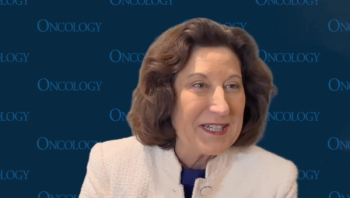
- ONCOLOGY Vol 20 No 11
- Volume 20
- Issue 11
No Scientific Challenge Was Too Daunting
October is National Breast Cancer Awareness Month, a good time to briefly reflect on what cancer "awareness" means to the oncology community and to the growing number of breast cancer survivors nationwide
ABSTRACT: 35 Octobers since War on Cancer declared, breast cancer less of a taboo but still a killer
October is National Breast Cancer Awareness Month, a good time to briefly reflect on what cancer "awareness" means to the oncology community and to the growing number of breast cancer survivors nationwide.
Thirty-five Octobers have passed since the National Cancer Act of 1971 was signed into law. Referred to as the "War on Cancer," this groundbreaking legislation made conquering cancer a national priority. After all, we had recently put a man on the moon; no scientific challenge seemed too daunting.
Remarkably, putting a man on the moon proved easier than curing the hundred or so disease entities comprising cancer; it became painfully evident that declaring war on cancer was easier said than done. However, as hope for a "silver bullet" cure was tempered by our growing knowledge of cancer's vast biologic complexities, a national cancer awareness movement was beginning to bloom. As we know now, it proved to be a good thing, for physicians and patients alike.
Lest we lose sight of our accomplishments, it is important to remember that in the early 1970s breast cancer was largely a taboo subject, rarely discussed outside of the physician's office. There were no Internet websites or advocacy groups to turn to for information and support, resources we now take for granted. This lack of awareness and open public discussion left American women vulnerable and voiceless when it came to their breast health.
In 1974 Betty Ford became the first high-profile American woman to publicly discuss her breast cancer diagnosis and treatment. Mrs. Ford's public handling of her breast surgery when she was First Lady influenced women and helped prompt a significant change in public attitude.
In that same year, two other women who were diagnosed with breast cancer made prominent contributions to the advocacy movement: Susan G. Komen, whose legacy became the Susan G. Komen Breast Cancer Foundation, raising millions of dollars for breast cancer research, and journalist, Rose Kushner, whose unflinching personal memoir about her own battle with cancer inspired women to be proactive partners in their breast health decisions.
Many survivors took their cue from these pioneering women. They began discussing their own experiences and many women had their first mammograms, believing that breast cancer may, in fact, be treatable and not a death sentence. Moreover, this nascent awareness paved the road for the breast cancer advocacy movement, which would soon become a template for political and public healthcare activism in this country.
Progress in breast cancer came, in part, because it followed the money. In the 1980s, breast cancer advocates began lobbying private and public entities for more funding. Led by breast cancer survivors, these determined women brought the issue to the steps of Capitol Hill. Their commitment and knowledge-based advocacy for women's breast health mobilized millions of cancer patients and their families.
Within a decade, the breast cancer advocacy movement became a potent political force, literally shifting the way cancer research was funded. Bear in mind that the year the National Cancer Act was signed, total funds allocated by the government for cancer research was about $1 million. The current annual NCI budget is but one example of their impact: $566 million for breast cancer research alone.
Although much progress in the laboratory and clinic has been made, breast cancer is still a daunting killer. It is the number 2 cause of cancer death among women; more than 40,000 American women will succumb to the disease this year alone. But far too often we become mired in grim statistics and clinical data. So sometimes it's good to revisit the past, to see how far we've really come. Early detection methods have improved, our drugs are more effective and far less toxic, and our national commitment to delivering and documenting the highest standard of quality care has become a mission within the oncology community.
Again, if we look back in time across the clinical and social landscape, much has changed in our national psyche since we first declared war on cancer. We are less naive, but no less committed. The fact that we designate October as "Breast Cancer Awareness Month" is one small reminder of that. And although we have not cured cancer, it is not a promise unfulfilled. As the former director of the national Cancer Institute, Richard Klausner, MD, remarked, "We may not know how to cure cancer yet, but we know what we need to do to get there. And that's very exciting."
It certainly is.
Ronald Piana
Senior Editor, ONCOLOGY
Articles in this issue
about 19 years ago
Epocrates Helps Clinicians Address Patient Safety Needsabout 19 years ago
Treating Advanced Breast Cancer in the Older Woman: Review 2about 19 years ago
Treating Advanced Breast Cancer in the Older Woman: Review 1about 19 years ago
Exercisers May Have Better Breast Cancer Survivalabout 19 years ago
Cancer Pain Management in the 21st Century: Review 3about 19 years ago
FDA Approves Amgen's Panitumumab to Treat Advanced Colon CancerNewsletter
Stay up to date on recent advances in the multidisciplinary approach to cancer.

















































































